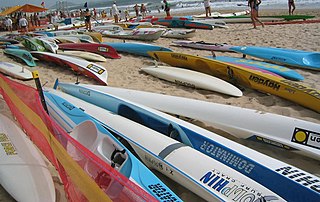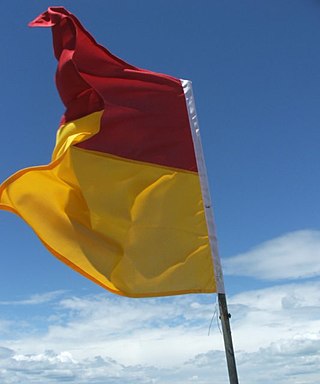
Surf lifesaving is a multifaceted social movement that comprises key aspects of voluntary lifeguard services and competitive surf sport. Originating in early 20th century Australia, the movement has expanded globally to other countries, including New Zealand, Ireland, South Africa, and the United Kingdom. Surf lifesavers in Australia are colloquially known as "Clubbies".

Drowning is a type of suffocation induced by the submersion of the mouth and nose in a liquid. Submersion injury refers to both drowning and near-miss incident. Most instances of fatal drowning occur alone or in situations where others present are either unaware of the victim's situation or unable to offer assistance. After successful resuscitation, drowning victims may experience breathing problems, vomiting, confusion, or unconsciousness. Occasionally, victims may not begin experiencing these symptoms until several hours after they are rescued. An incident of drowning can also cause further complications for victims due to low body temperature, aspiration of vomit, or acute respiratory distress syndrome.

A lifeguard is a rescuer who supervises the safety and rescue of swimmers, surfers, and other water sports participants such as in a swimming pool, water park, beach, spa, river and lake. Lifeguards are trained in swimming and CPR/AED first aid, certified in water rescue using a variety of aids and equipment depending on requirements of their particular venue. In some areas, lifeguards are part of the emergency services system to incidents and in some communities, lifeguards may function as the primary EMS provider.

The German Life Saving Association is a relief organization for life saving in Germany. The DLRG is the largest voluntary lifesaving organization in the world.
The Royal Life Saving Society UK is a drowning prevention charity founded in 1891 in the UK. It has had Royal Patronage since 1904.
Surf Life Saving Northern Region is the largest of four regions that make up Surf Life Saving New Zealand. As of the 2021/2022 season, it is made up of 18 clubs that look after 22 patrol locations from Ahipara to Raglan on the West Coast and from Whangārei Heads to Takapuna on the East Coast.

Surf Life Saving New Zealand (SLSNZ) is the national association representing 74 Surf Life Saving Clubs in New Zealand. The organisation's motto is 'In it for Life'. This refers to both the long relationship many members have with the organisation, as well as to the organisation's purpose of preventing drowning and injury, thereby saving lives.

The International Life Saving Federation (ILS) is an organisation for drowning prevention, water safety, lifesaving and lifesaving sports.

The United States Lifesaving Association is a nonprofit professional association of beach lifeguards and open water rescuers in the United States.

The Royal Life Saving Society Canada, commonly known as the Lifesaving Society or LSS, is a Canadian registered charity that works to prevent water-related injuries through various programs across Canada. The Lifesaving Society is an independent organization that is composed of ten provincial/territorial branches, tens of thousands of individual members, and over 4,000 affiliated swimming pools, waterfronts, schools and clubs. The Society helps prevent drowning and aquatic injury through its training programs, public education, drowning-prevention research, safety management and overseeing the sport of lifesaving. They are one of five nationally recognized first aid training organizations in Canada, alongside the Heart and Stroke Foundation, Red Cross, St. John Ambulance, and the Canadian Ski Patrol.

Surf Life Saving Australia (SLSA) is an Australian not-for-profit community organisation that promotes water safety and provides surf rescue services.

Lifesaving is the act involving rescue, resuscitation and first aid. It often refers to water safety and aquatic rescue; however, it could include ice rescue, flood and river rescue, swimming pool rescue and other emergency medical services. Lifesaving also refers to sport where lifesavers compete based on skills, technique, speed and teamwork. Lifesaving activities specialized in oceanic environment is called surf lifesaving or coastal lifesaving.

Bondi Rescue is an Australian factual television program which is broadcast on Network 10. The program follows the daily lives and routines of the Waverley Council professional lifeguards who patrol Bondi Beach.
The ILS World Life Saving Championships are the world championships for lifesaving sport events. They are sanctioned by the International Life Saving Federation (ILS), conducted every 2 years, and formerly marketed and known as the ‘Rescue’ series, for example – Rescue 2008.
National Water Life Saving Association (NWLSA), also known as Chinese Taipei Water Life Saving Association (CTWLSA), is the major lifesaving organization in Taiwan. The organization's members are mainly volunteer lifesavers, police officers, firefighters and civilians who are enthusiastic about water sports, water safety awareness and water rescue events.
The International Surf Lifesaving Association (ISLA) is a nonprofit organization that advances professional lifesaving development to areas in need around the globe. ISLA uses latest technology to identify areas in need. ISLA advances development through lifeguard training programs and aquatic rescue operation consults, lifeguard exchanges, equipment donations, and by integrating with drowning prevention organizations to share information, techniques, stories, and culture.

American Red Cross Volunteer Life Saving Corps Station is a national historic site located at 2 Ocean Front North, Jacksonville Beach, in Duval County. As of 2014, the building is a part of to the National Register of Historic Places. The historic lifeguard station was donated to the city of Jacksonville Beach, the American Red Cross logos were removed, and the city continues to use it for lifeguards.
Simon Lewis is an Australian lifeguard and volunteer surf lifesaver. Once the former St Kilda Lifesaving Club Captain, he is the only Australian lifeguard to have worked both major migration routes in Europe. He first became part of a team of six on lesvos Greece with International Surf Lifesaving Association (ISLA). Since joining the mission with ISLA, Lewis has completed seven humanitarian rescue missions with six NGOs saving the lives of over 1,900 African and Syrian refugees as they attempted to cross the dangerous waters of the Mediterranean Sea to Greece and Italy. As well as being the first Australian to become the head of mission on the central migration route for the German NGO Mission Lifeline, Lewis participated in the Asylum Seeker Resource Centre (ASRC) yearly telethon which raised over $800,000 for the organisation to continue to help those in dire need.
The Freshwater Surf Life Saving Club, established in 1908, is located at Freshwater Beach in Australia. It has become a large volunteer organization with strong community bonds. The club was founded by a push from government to foster safer beach practices. It is a part of Surf Life Saving Australia, a not-for-profit organization committed to keeping the beach safe for patrons and providing beach rescue services. A visit to the club from United States' surfer, Duke Kahanamoku, in 1914 helped initiate the sport of surfing in Australia.
Pakistan Life Saving Foundation is a non-governmental organization (NGO) in Pakistan, established in 2004 to provide life-saving services on the beaches of Karachi. It is the country's only free, privately-run, near-shore drowning prevention and rescue body. It employs around 250 lifeguards recruited from the neighboring coastal fishing communities.










